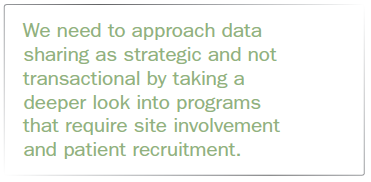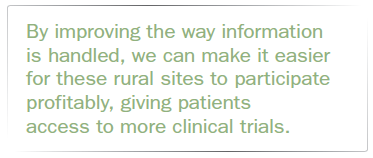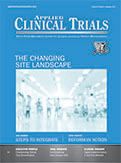Improving Information Exchange in Clinical Trials
Applied Clinical Trials
Executives from across the clinical research enterprise converge to discuss the steps-and technology-needed to strengthen industrywide data sharing.

Seamless information exchange remains a challenge in clinical trials. Trial times are getting longer, product development costs are rising, and getting treatments to patients is harder.
Former FDA Commissioner Scott Gottlieb emphasized the importance of life sciences and clinical research companies modernizing clinical studies by focusing on greater collaboration and data sharing.
The industry is also making this issue a priority, according to the Veeva 2019 Unified Clinical Operations Survey, which surveyed nearly 500 clinical operations professionals from around the globe. Industrywide, clinical leaders report the need to improve information exchange among study partners to reduce manual processes (71%), improve collaboration (66%), and increase visibility and oversight (64%) during trials. As more organizations focus on streamlining clinical processes and systems, stakeholders will be better aligned throughout the trial lifecycle to speed drug development.
Veeva recently brought together industry experts from across academia, sites, CROs, and sponsors (see list on facing page) to discuss opportunities to improve information exchange in clinical trials, the potential for technology to advance collaboration, and practical steps to impact positive change.
Jason Methia

Q: While the industry recognizes the need to improve clinical trial execution, experts point to a range of common challenges, including the inability to share information easily across stakeholders. What is preventing the seamless exchange of clinical trial information among stakeholders?
Doug Schantz: The lack of interoperability among data sources is one major challenge. Acquiring, combining, and analyzing the different types of clinical trial data all sourced from an innumerable number of vendors also present a huge challenge. With as many as 15 different vendors in a given study, analyzing and aggregating multiple data sources is never easy. Lack of standards means data is structured differently among dozens, if not hundreds of vendors.
Ken Getz: One of the biggest challenges is the fragmentation that exists within and between companies. The drug development enterprise has long operated in silos with limited coordination and integration among internal functions. This is exacerbated by the rising numbers of external service and solutions providers involved. This fragmentation manifests itself in the disparate and incompatible applications that disaggregate how data is gathered and managed.
Bree Burks: I believe that the biggest issue is that the groups with the operating capital and the technical capabilities to address this challenge are not involved with the day-to-day work of clinical trials and, so, do not prioritize the need for better information sharing.
I’m just starting to see healthcare facilities, insurance companies, and technology providers with the necessary assets start listening and working to help solve these issues. The involvement of these larger companies is required to drive change. The technology company must work directly with sponsors to create a connection that automates and retrieves data in the same way among all its stakeholders.
Jeff Kingsley: Too many parties are in the stack. In other industries, there is more direct communication with the customer. In our industry, an immense distance exists between the site and the sponsor. There’s the biotech company, the CRO, separate companies for invoicing and labs, and so on. The distance between the site and the sponsor is hampering industry growth by slowing the ability to communicate information and then successfully implement innovation.

Initially, the rationale for bringing in new vendors to the mix was to improve research and efficiency, but there’s no longer a direct line of communication between sponsor and site. This lack of communication creates barriers which are worsened by disparate, disconnected technologies.
Hunter Walker: I think the biggest hindrance is the lack of data exchange standards. Looking at the medical and electronic health record (EHR) world that is part of healthcare today, a lot of these companies developed big systems that have essentially created silos among stakeholders. After entering data into the system, the user has no easy means for data export, migration, or exchange. This dramatically impacts the communications between the site and CRO, as the CRO typically manages the EDC system and the site has its own EMR (electronic medical record)/EHR.
Q: What positive outcomes could be achieved by addressing these challenges?
Click to Enlarge discussion participants

Schantz: When you can gather and share data more easily, you win back time and money because you don’t need as much overhead internally to monitor and process data. Speed and cost savings would be the biggest impact when addressing data-sharing challenges. Companies could reinvest the savings to develop more innovative medicines. Right now, many can’t afford to develop their entire pipeline of new drugs because clinical trials are so expensive.
Getz: More open, coordinated, and integrated development holds numerous compelling promises: 1) faster access to more robust and comprehensive data and information supporting faster and more efficient decision-making; 2) accelerated insight into patient response to investigational therapies and into patterns of efficacy and safety that inform continuous learning; 3) better and more rapid identification of eligible patients and relevant professionals; 4) more convenient and flexible models that bring clinical trials to patients wherever and whenever they can most easily participate. Ultimately, these compelling benefits shorten development cycle times and lower development operating costs.
Burks: One positive result would be the ability to conduct more studies with fewer resources. There’s some fear across academic medical centers that the industry will take studies away from us. About 40% of our effort concentrates on data abstraction and data entry, and technology removes much of that burden. By eliminating this work, sponsors can use those resources to support additional studies and better understand the data science capabilities of places like Vanderbilt.
Kingsley: If we solved this information exchange issue, all parties would have a closer relationship and be able to work together more flexibly. This is so important for a successful clinical trial because we are in a complex working environment where it’s very easy to make seemingly inconsequential mistakes that cause big problems down the road-something as simple as a wrong date on an invoice.
Site turnover is another issue that could be alleviated by improved collaboration. Metrics from Tufts indicate that the churn rate is getting worse. Principal investigators may be more likely to stay if the day-to-day burdens like double data entry were eliminated; then we would have more experienced investigators able to manage more trials.
Walker: Coming from the mid-sized CRO perspective, we would like it if our clinical research associates (CRAs) didn’t have to travel so often to sites to verify data by reconciling the TMF (trial master file) with the site’s trial binder. Less travel would benefit both the CRO and industry; eventually, the CRA role and the data manager role would merge. The net result would be more trials with greater efficiency.
Less travel also means that CRAs could focus more on relationship-building and training with the sites, which could lead to better protocol compliance. In a time when drug development is focused on precision medicine, trials will entail collecting even greater volumes of data to ensure FDA compliance. Less travel would increase efficiency to support the future of more complex trials.
Q: What concerns are holding some stakeholders back from adopting new technology to support collaboration?
Schantz: The technology is starting to come around but the big question is who should be making the investment? It depends. Right now, it’s not clear who should be paying for site-facing technology that resides at the site. That’s an issue under exploration.
Where there is the opportunity for site-facing technology, expecting the sites to have one standard is no fairer than expecting the sponsors to have one standard. This discussion should start with site-facing technology opportunities such as eTMF and maybe even beyond. Or, even with pre-processors for EHRs to allow them to load into the EDC system. Sponsors and sites must start a dialogue around this issue. If a site has certain standards, it doesn’t necessarily mean that they’re compatible with sponsor standards.
Schantz: Many argue that technology exists to support a vision for open, integrated innovation. However, high-level operating fragmentation, absence of clear regulatory direction, high risk aversion, challenges of juggling legacy and new development activity, and the dysfunctional ways that companies adopt innovation contribute to the huge barriers that hold back various stakeholders.
Burks: One concern for academia is how we tend to look internally to solve this problem. Instead of working in isolation and looking for solutions that address just our needs, we must find opportunities to leverage established technology and channels. We have to stop being narrow-minded with creating solutions just for our academic medical center instead of thinking about the bigger problem.
For example, instead of determining how to just automate our own data exchange, we should look to the sponsor or CRO that already has a relationship with a technology company that can integrate processes across sites. Instead of taking on the burden, we can focus on how to improve patient engagement and how to locate patients. These align with our core competencies much more than technology automation or information exchange across stakeholders.
Kingsley: Sponsors are multi-billion-dollar behemoths with quite a bit of bureaucracy. When deciding their budgets and budgetary approval rules regarding what they will pay and what is negotiable without escalation, they design it for the average research site. The average research site, on the other hand, doesn’t even question technology, as they are not investing in it. Any investment in technology with a sponsor is outside of the budget paradigm and rules of site engagement. The issue must be escalated, causing timeline delays which hurt both parties. So, we’re always balancing our budget negotiations with the acknowledgment that time matters so that the sponsor can start collecting data.
I believe that sponsors should compensate sites for investing in technology. We’ve invested in e-source, e-reg, and artificial intelligence but have not found any sponsors willing to compensate us for anything. I explain to sponsors that investing in these technologies doesn’t significantly benefit me-it benefits them much more. The typical response is that technology is just the cost of doing business.
Walker: There is confusion in the industry about who should make the investment in technology. I believe that funding should come from sponsors, as they are on the top of the pyramid and stand to gain the most. However, I do think that CROs must be willing participants and make some contribution as they predominantly interface with the sites. CROs should encourage sponsors to look at how they can better support sites as well as be willing to support technology adoption internally.
Sites should remain focused on patient care, but they need new tools to better conduct research. In the last 20 years, the industry shifted the burden of data entry onto the sites. Originally, CROs manually created case report forms on paper with data entry personnel entering information into the data management system. When EDC systems arrived, sites entered the data directly, which eliminated the middle step but has also increased the burden on sites. Therefore, it is fitting for pharma to make the largest investment in technology to improve data input and exchange. Easier data entry for sites means trials can be conducted faster.
Q: Looking three to five years in the future, how would the dynamic between sites, sponsors, and CROs change if information exchange were more simplified, streamlined, and even automated?
Schantz: Seamless information exchange would greatly enhance the ability to transmit more unstructured patient data along with structured data to get a more accurate and complete view of the patient and their response to a medication.

I don’t see interactions with CROs changing dramatically, but dynamics between sites and sponsors will change. The interoperability and ability to transmit data will reduce burdens on sites to speed trials and improve visibility for sponsors. It creates opportunities for increased data sharing, interoperability, and automation to support more strategic relationships between sites, sponsors, and CROs. We need to approach data sharing as strategic and not transactional by taking a deeper look into programs that require site involvement and patient recruitment.
Streamlined information exchange would also make it easier for sites to support new trials. The decreased information overload and administrative burden would lower the cost of entry to participate in clinical trials.
Burks: I anticipate new types of support services to bridge the gap between large, private CROs, and people doing the work. New companies describing themselves as “integrated research organizations” (IROs) are partnering with academic medical centers to really know their systems, issues, and what’s going on in the pharma and CRO world. As data is automated and embedded into more informatics and systems, I foresee IROs serving as a bridge between sites and even the healthcare system.
IROs feed a pipeline of studies, identifying technology systems and even research coordinators that can get the work done so that the academic medical centers and the health systems can focus their staff on being experts in the therapeutic area and take a more patient-centered approach. This model can help institutions like Vanderbilt provide exceptional clinical care through discovery and innovation.
Kingsley: The ideal result of improved information exchange would be transparency. With transparency, I could communicate, for instance, more directly with the medical monitor and make third parties aware of important notes or conversations without repeating everything.
The positive outcome is faster, more efficient trials, with a better relationship among different parties now siloed from each other in their processes. We would have fewer emails, less one-to-one communication, and a pool of centralized information from which everyone could learn. Conservatively, we probably spend two hours daily responding to redundant emails. Eliminating them would be a huge time saver. In addition, transparent data sharing would support greater confidence among partners and improved decision-making.
Walker: I think there is fear that sponsors wouldn’t need CROs as much. However, I believe CROs would adapt and move toward forging better relationships with sites. Much of outsourcing today is just transactional. Sites see patients and enter data while we ensure the site enters it cleanly. By improving information exchange and empowering sites with better technology to do that more efficiently, they can conduct better research. With CRO training, sites could begin to take the time to actually look at collected data, which doesn’t happen very often now.
Q: How would these changes trickle down to the patient and impact the patient experience?
Schantz: Ultimately, improved collaboration means getting new medicines to patients more quickly. Lowering entry barriers to conduct clinical trials would open the door for more patient participation as well as more sites. With medical staff less burdened with routine tasks like data entry, they will also have more time to focus on patient care. Study coordinators can spend less time inputting information and engage with patients in a more memorable and intimate way that improves study results.
Getz: All benefit under the aspirational model of open, integrated innovation. Notably, open innovation is necessary to achieve a higher level of patient engagement desired by both the public and patient communities, especially with the growing focus on rare disease therapies.
The professional community, too, will covet faster access to more robust and comprehensive data and information that supports faster and more efficient decision-making; accelerates insight into patient response to investigational therapies and patterns of efficacy and safety that inform continuous learning; rapid identification of eligible patients and relevant professionals; and convenient and flexible models that bring clinical trials to patients in locations most convenient to them.
Burks: This technology should allow us to put patients in control. We’ve seen this paradigm with Uber and Lyft as well as in the banking space, where technology puts the customer in control, with new options and awareness. I do think that patients will gain this kind of control of their own healthcare and have more options, a new term called “clinical research as a care option.”
Technology also will connect patients directly to sponsors, who may not need as many middlemen collecting data. Doc AI is an example of an artificial intelligence company that enables patients to join medical studies and input data. They already have around 40,000 users. These types of resources give patients control of their own healthcare record that they can submit directly to the sponsor.
Kingsley: Our coordinators spend 70% of their time at a computer responding to redundant emails and queries rather than with the patients. Freeing coordinators from mundane administrative work would increase patient interaction and retention.

Walker: More patients could participate in clinical trials, especially in rural settings where populations are underserved from a clinical trial participation standpoint. By improving the way information is handled, we can make it easier for these rural sites to participate profitably, giving patients access to more clinical trials.
Jason Methia is Vice President, Site Strategy, Veeva Systems

Improving Relationships and Diversifying the Site Selection Process
April 17th 2025In this episode of the Applied Clinical Trials Podcast, Liz Beatty, co-founder and chief strategy officer, Inato, discusses a number of topics around site engagement including community-based sites, the role of technology in improving site/sponsor relationships, how increased operational costs are impacting the industry, and more.
Behind the Buzz: Why Clinical Research Leaders Flock to SCOPE Summit
February 7th 2025In this episode, we meet with Micah Lieberman, Executive Conference Director for SCOPE Summit (Summit for Clinical Ops Executives) at Cambridge Innovation Institute. We will dive deep into the critical role of collaboration within the clinical research ecosystem. How do we bring together diverse stakeholders—sponsors, CROs, clinical trial tech innovators, suppliers, patients, sites, advocacy organizations, investors, and non-profits—to share best practices in trial design, program planning, innovation, and clinical operations? We’ll explore why it’s vital for thought leaders to step beyond their own organizations and learn from others, exchanging ideas that drive advancements in clinical research. Additionally, we’ll discuss the pivotal role of scientific conferences like SCOPE Summit in fostering these essential connections and collaborations, helping shape the future of clinical trials. Join us as we uncover how collective wisdom and cross-industry partnerships are transforming the landscape of clinical research.
FDA-Approved Gene Therapy Beqvez Shows Sustained Efficacy, Safety in Long-Term Hemophilia B Trial
April 17th 2025Beqvez (fidanacogene elaparvovec), an FDA-approved one-time gene therapy for hemophilia B, demonstrated sustained factor IX expression, low bleeding rates, and a favorable safety profile over long-term follow-up.